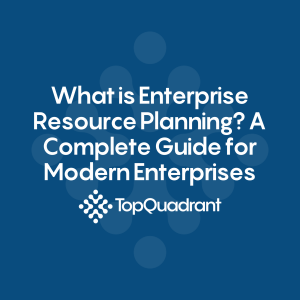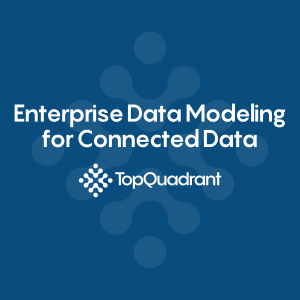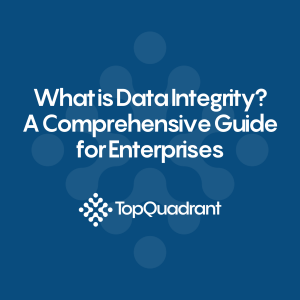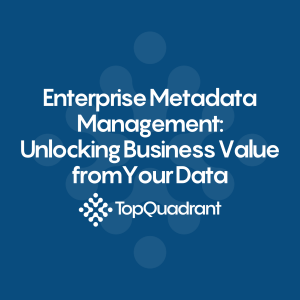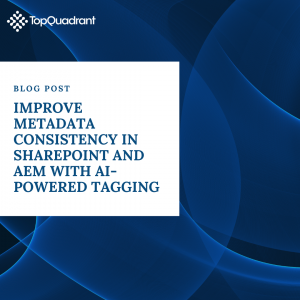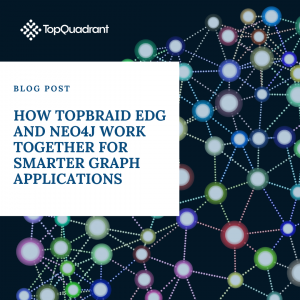Blog | Metadata Management Tools for Governance and AI Readiness

TopQuadrant has been recognized in the 2025 Gartner® Magic Quadrant™ for Metadata Management Solutions as an Honorable Mention
“Metadata management solutions are undergoing a significant evolution, shifting from augmented data catalogs to metadata “anywhere” orchestration platforms, acting as technology enablers. D&A leaders must consider the market evolution and vendor landscape as they start data and AI journeys.”
- 2025 Gartner® Magic Quadrant™ for Metadata Management Solutions, by: Melody Chien, Thornton Craig, Guido De Simoni, Roxane Edjlali, 19 November 2025
Metadata management tools have become the cornerstone of modern data governance strategies. As enterprises strive to make their data more discoverable, reliable, and actionable, metadata management software helps them organize and understand the data that fuels every decision. These tools not only catalog and track data assets but also provide the foundation for data governance, compliance, AI readiness, and business agility.
Metadata management is no longer a back-office function. It is an enabler of innovation, allowing organizations to connect business concepts to technical data assets and align teams across IT, analytics, and business units. Metadata management tools make this possible by providing a structured, collaborative way to describe, organize, and activate data across the enterprise ecosystem.
Why Metadata Management Tools Are Essential
Every organization generates vast amounts of data across systems, departments, and platforms. Without a way to organize and interpret this data, it becomes fragmented and difficult to use effectively. Metadata management tools address this challenge by providing a single framework for managing data about data – contextual information such as where data originates, how it changes, who uses it, and what rules govern it.
In the past, metadata management was treated as documentation. Today, it is an operational discipline supported by powerful technology. These tools help organizations automate the collection of metadata, establish governance policies, enforce data quality standards, and ensure compliance with internal and external regulations. They also play a critical role in AI and analytics initiatives by ensuring data is well-defined and ready for machine learning models and automated pipelines.
The Role of Metadata Management in Enterprise Data Strategy
Metadata management is a bridge between business and technical teams. For business users, it provides clear visibility into where data comes from and how it is used in reports, dashboards, and decisions. For technical teams, it delivers lineage and traceability, showing how data flows through systems and transforms over time. Together, these capabilities help create a shared understanding of enterprise data assets.
Enterprises use metadata management tools to create centralized data catalogs, automate data lineage mapping, standardize definitions, and manage semantic relationships across data assets. These capabilities are essential for data governance frameworks, regulatory compliance (such as GDPR and HIPAA), and integration with modern data platforms like Snowflake, Databricks, and data lakehouses.
As organizations adopt AI and automation, metadata management becomes even more critical. AI models rely on high-quality, well-documented data. Metadata provides the foundation for AI transparency, explainability, and trustworthiness – ensuring that automated decisions are based on accurate and well-governed information.
Core Capabilities of Metadata Management Tools
While every enterprise has unique data needs, most metadata management tools share several core capabilities that enable visibility, control, and collaboration across data ecosystems.
One essential capability is automated metadata harvesting. Instead of requiring manual entry, modern tools connect directly to databases, data warehouses, ETL systems, and APIs to collect metadata automatically. This helps maintain an always-current view of the data landscape.
Another critical function is data lineage tracking. Data lineage allows teams to visualize how data moves and transforms across the organization. This transparency is vital for troubleshooting data quality issues, ensuring compliance, and maintaining trust in analytics outputs.
Metadata management platforms also offer robust governance workflows. They allow administrators to assign ownership, stewardship, and approval processes for metadata updates, ensuring accountability and consistency across departments. Many platforms integrate with business glossaries to align technical definitions with business terminology.
Search and discovery are additional pillars of effective metadata management. Business users can find data assets through natural language search, filter by category or domain, and understand relationships across datasets. By making data more accessible, metadata management tools empower self-service analytics and reduce dependence on IT.
Beyond Cataloging: Intelligent Metadata Management
The newest generation of metadata management tools goes beyond cataloging and documentation. These tools use AI and knowledge graph technology to infer relationships, classify data automatically, and provide contextual insights. Intelligent metadata management enables organizations to move from static documentation to active metadata that drives decision-making.
Knowledge graph-based metadata management tools model relationships between data elements in a way that mirrors human understanding. Instead of viewing metadata as rows in a table, knowledge graphs represent entities, attributes, and relationships. This structure allows enterprises to query data contextually, find hidden connections, and integrate business semantics directly into their data architecture.
Intelligent metadata management also improves automation. For example, machine learning algorithms can recommend classifications for new data assets, suggest related datasets, or flag anomalies. This dynamic approach helps enterprises maintain governance at scale without sacrificing agility.
How Metadata Management Tools Support Data Governance
Data governance depends on a strong metadata foundation. Governance policies require clear documentation of data definitions, ownership, and lineage. Metadata management tools operationalize these policies by embedding governance rules directly into data systems.
For instance, when data governance teams define a policy around personally identifiable information (PII), metadata tools can automatically tag and track where PII exists across systems. They can also enforce access controls, alert teams to violations, and maintain audit trails for compliance purposes.
By linking governance frameworks to metadata repositories, organizations can ensure policies are applied consistently. This alignment reduces compliance risks, improves data quality, and strengthens trust in enterprise analytics.
Metadata management also supports regulatory initiatives by providing the transparency auditors require. Instead of manual spreadsheets or disconnected systems, enterprises can use metadata management platforms to demonstrate lineage, ownership, and access history across their entire data landscape.
Choosing the Right Metadata Management Tool
Selecting the right metadata management tool depends on an organization’s size, complexity, and data maturity. Some tools focus primarily on cataloging and discovery, while others emphasize governance, automation, or semantic modeling.
Enterprises with complex ecosystems often look for tools that integrate seamlessly with existing data platforms, support APIs for extensibility, and provide automation capabilities for large-scale metadata ingestion. For organizations that operate in regulated industries, features like data lineage visualization, access control, and audit reporting are essential.
Another key factor is collaboration. Metadata management is not a one-time project but an ongoing discipline that involves stakeholders across the business. Tools that provide intuitive interfaces, role-based permissions, and comment or review features enable cross-functional participation and long-term adoption.
Finally, scalability matters. As data volumes grow and new sources emerge, enterprises need metadata management solutions that can scale with them. Cloud-native platforms and graph-based architectures offer flexibility for evolving data landscapes.
Integrating Metadata Management with Modern Data Architectures
Metadata management tools are most powerful when integrated into the broader data ecosystem. Modern architectures like data meshes, lakehouses, and knowledge graphs rely on metadata to function effectively. These architectures distribute data ownership across teams, making metadata management critical for maintaining consistency and interoperability.
Integration with data integration tools, data warehouses, and analytics platforms allows metadata to flow seamlessly between systems. This ensures that business users see consistent definitions and technical users have complete visibility into data transformations. When metadata is embedded across systems, organizations gain a unified, trusted view of their data assets.
Metadata management also plays a central role in data observability and quality management. By combining lineage information with monitoring tools, enterprises can detect issues such as schema changes, broken pipelines, or anomalies in near real time. This proactive approach strengthens both governance and analytics performance.
The Future of Metadata Management Tools
As data ecosystems become more distributed, the role of metadata will continue to evolve. Metadata management tools are moving toward automation, intelligence, and interoperability. They are no longer passive catalogs but active engines that drive governance, discovery, and AI readiness.
Future tools will continue to leverage AI to classify data, suggest relationships, and automate workflows. They will also become more user-centric, providing contextual insights to business users directly within their analytics and BI platforms. Integration with LLMs and natural language search will make metadata more accessible than ever.
Another major trend is the use of metadata to improve AI and machine learning governance. Organizations will rely on metadata to track model inputs, outputs, and decisions, ensuring transparency and compliance in AI-driven operations. Metadata will also play a role in prompt engineering, retrieval-augmented generation, and data provenance for AI systems.
Common Challenges in Metadata Management
Despite its value, metadata management can be challenging. Many organizations struggle with inconsistent data definitions, duplicate metadata sources, or siloed ownership. Without clear governance, metadata repositories can become outdated or incomplete.
Another challenge is balancing flexibility with control. Business users want easy access to data, while IT teams need to maintain security and compliance. Metadata management tools must bridge this divide by providing controlled self-service capabilities backed by governance workflows.
Integration is also a common hurdle. Enterprises often use dozens of systems that store metadata in different formats. Successful metadata management requires tools that can unify these sources through APIs, connectors, and semantic mapping.
Finally, achieving adoption can be difficult. Metadata management initiatives often require cultural change as much as technical change. Success depends on building collaboration between data engineers, business users, and governance leaders. When implemented effectively, metadata management tools can transform the way organizations work with data.
Metadata Management Tools and Business Impact
The business impact of effective metadata management extends far beyond data governance. It improves efficiency, accelerates analytics, and enhances decision-making across the enterprise. With a unified view of data, teams can spend less time searching for information and more time generating insights.
Metadata management tools also reduce risk by ensuring compliance and improving data quality. They provide transparency across the data lifecycle, which is essential for regulated industries such as finance, healthcare, and life sciences. By improving trust in data, they enable better strategic planning and innovation.
From a cost perspective, metadata management helps eliminate redundancy and optimize storage by identifying duplicate or outdated data assets. It also supports faster onboarding for new systems and users by providing clear documentation and standardized definitions.
In short, metadata management is not just a technical function. It is a business capability that drives efficiency, compliance, and innovation.
Getting Started with Metadata Management
Organizations beginning their metadata management journey often start by cataloging key data sources and establishing a business glossary. This foundation allows teams to identify gaps, define ownership, and prioritize governance efforts. From there, enterprises can expand into automated lineage mapping, classification, and integration with analytics systems.
Success in metadata management depends on collaboration and continuous improvement. Metadata evolves as data evolves, so the process must be ongoing. Establishing clear stewardship roles, implementing governance workflows, and selecting a scalable platform are key to building a sustainable framework.
Metadata management tools provide the technology to make this possible, but the strategy must come from the organization itself. Aligning metadata management with business goals ensures that every initiative supports measurable outcomes – whether improving data discovery, reducing compliance risks, or enabling AI-driven insights.
Conclusion
Metadata management tools have become indispensable for enterprises seeking to harness the full potential of their data. They transform raw information into a structured, governed, and actionable resource. By combining automation, governance, and intelligence, these tools enable organizations to create a trusted data foundation for analytics, AI, and digital transformation.
As data continues to expand in volume and complexity, metadata management will only grow in importance. Enterprises that invest in the right tools and frameworks will gain a competitive edge through greater efficiency, transparency, and adaptability. Metadata management is not just about organizing data – it is about unlocking its meaning, context, and value across the enterprise.
-
Data Governance67
-
Vocabulary Management9
-
Knowledge Graphs43
-
Ontologies15
-
Data Fabric8
-
Metadata Management18
-
Business Glossaries6
-
Semantic Layer11
-
Reference Data Management7
-
Uncategorized2
-
Data Catalogs15
-
Datasets11
-
Taxonomies4
-
News5
-
Policy and Compliance5
-
Life Sciences6
-
Automated Operations6
-
Financial Services9
-
AI Readiness25
-
Podcasts1
